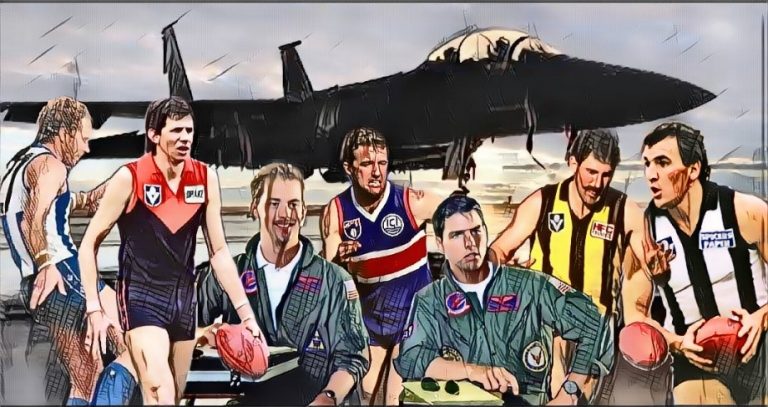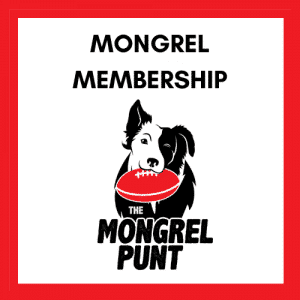The wing position has seen a bit of a renaissance in recent seasons, with players like Josh Daicos, Paul Seedsman, Sam Menegola, and Ed Langdon counted as some of the premier running men in the game.
The All-Australian selectors have yet to really catch onto the significance of wingmen in the modern game, often opting to use the positions in the team as additional midfield roles to squeeze in players who normally start in the centre square. Andrew Gaff was the last genuine wingman to make the cut.
But not giving consideration to those plying their trade out wide does a real disservice not only to those players, but to the game itself. Specialist wingmen are in vogue again, and with teams often looking at utilising the “fat side” to generate run and open up the forward 50, the running of players like Daicos, Sidebottom, Isaac Smith, and now even Mason Wood is as important as it ever was.
And it has been vital in the past.
If I asked you to list the greatest wingmen you’ve ever seen, the names should roll off your tongue relatively quickly. Any AFL fan worth their salt knows the names of Peter Matera, Michael Long, Keith Greig and Robbie Flower, and if you don’t, do yourself a favour and look up a few of their highlights.
I was lucky enough to be dragged along to Arden Street in the late 70s and early 80s, and it was there I found my first ever favourite player – Wayne Schimmelbusch.
‘Schimma’ was a great wingman and a wonderful player overall. He was hard as nails, ran as long and hard as anyone else on the park, and was driven to win, often being the first to put his hand up when the side needed someone to inspire them. I had a wooden-backed poster of him on my bedroom wall; he was baulking an imaginary opponent on an empty field – the same kind of pose you’d find on a Scanlens footy card in that era. I hit the roof one day when I got home and my step-brother had used it as a backing board to complete his graphics homework.
That step-brother was four years older than me, so he handled my rage pretty easily, but I did steal his football while he was on camp, kicked it on the roof at school, and denied ever taking it, so… screw him.
Anyway, I have fond memories of Schimma breaking lines as he ran through the middle of Arden Street, but even on his own team, I had little doubt that his role on the wing paled in comparison to the bloke on the other wing.
Keith Greig didn’t just run down the wing, bouncing the football. He was otherworldly in the way he would cover the ground – almost as though he was gliding along, and his ability to finish on the run was something North Melbourne relied on for years after Greig’s Brownlow-winning days were done and dusted. But was he the best ever?
And if not, who could match him?
It was a shame that Robert Flower was stuck on a team that was such an afterthought during his time at Melbourne. The Dees were a perennial cellar dweller, and Flower played in just two teams that finished with winning records in his 15 seasons in red and blue. Despite the ineptitude of his team, Flower’s performance wavered very little. His ability to fly down the MCG wing with the grace of a gazelle was a sight to behold, and you will hear the older generation gush about how good he was with the footy in hand.
There are not many players who have a wing named after them, but Doug Hawkins had one named after him, unofficially, whilst he was still playing. Hawkins was a beautiful kick of the football and in over 300 games with the Bulldogs, was one of the genuine “heart and soul” players at the club.
I had a few friends as a young fella who wanted to wear the number seven on their backs as tribute to Hawkins, and the way he played the game. He was a bit of a “lad” and had to be pulled into line by the intimidating Mick Malthouse upon his arrival at the club. Hawkins responded with his best football, winning the Charlie Sutton Medal in 1985, and making the VFL Team of the Year in both ‘84 and ’86.
For mine, Hawkins falls into the same category as Flower – a great player stuck on a pretty ordinary team for most of his career. In his 18 seasons (I didn’t forget the Fitzroy season), Hawk had five winning seasons (and two where the Dogs had as many wins as losses).
Robert DiPierdomenico ran down the wing for the Hawks in both the 70s and 80s, and played the role very differently to most. Whilst most wingmen are outside runners, Dipper brought a sense of toughness (and some may call it thugishness) to the position, as he often ran afoul of the umpires and tribunal.
Dipper was damaging in the contest, hard to tackle and found himself with a Brownlow hanging around his neck as a result at one stage. In a great backhander from former coach, the late Allan Jeans once quipped that Dipper was “a great player when he wasn’t trying to be one,” indicating that Dipper started to believe his own press after winning the medal in 1986, however, Dipper also did the tough things for his team, often laying big tackles to hold up the momentum of the opposition. He was a brilliant counterpunch to the classy Darrin Pritchard on the opposite wing for the hawks, who made a habit of lacing it out to Jason Dunstall.
Similar to Dipper, Darren Millane brought some genuine grunt to the role, and was more like a runaway bull than the silky smooth wingmen of days gone by. With six seasons of 20+ touches per game to his name, and one of the main reasons for the first Collingwood premiership in 32 years in 1990, Millane’s tragic passing tore the heart out of the club. How would we be speaking of him, historically if he was able to play out his career on the wing? He was just 26 at the time of his passing – right at his peak.
Another who always caught my attention – only in part because he was my neighbour in Moonee Ponds and would kick the footy with the local kids – was the late Merv Neagle. His blistering run and ability at Essendon quickly established him as a favourite amongst Bomber fans… right up until he buggered off to Sydney, where he played out the remainder of his footy career.
Craig Bradley played excellent footy for the Blues over a number of years, relishing the position of using his pace and endurance to tear games apart. I can remember people waiting for Bradley to get worse, and for age to catch up with him, yet there he was… still burning players off into his mid-30s. In an astonishing stat, he played 17 seasons in the league and never once averaged below 20 touches per game. Outstanding!
Chris Mainwaring was a star for the West Coast Eagles right from their inception, and would be an integral part of their first two premierships. He was more of a burst player than an endurance athlete, but was better overhead than most wingers.
In 1993, Michael Long tore a Grand Final apart playing on the wing, earning himself a Norm Smith Medal, and in the process kicked one of the more memorable Grand Final goals. Did Silvagni touch it? The umpire said no, and that’s all that matters.
But are we forgetting someone?
Ah yes… this Ablett fella. He could play a little bit, couldn’t he? And before he dominated the forward 50, kicking tons of goals in a season, Gaz played on the wing. Whilst we’re here talking about the prowess of some wingers to run forward and hit the scoreboard, Ablett would laugh at their production.
In 1985, Ablett averaged 4.1 goals per game, and jumped to 4.33 goals per game in 1986. I wonder how we would view Ablett Senior had he not moved forward for the second half of his career? Could he have been the greatest wingman to ever grace a footy field?
Not if Peter Matera had anything to say about it.
I have to admit, I am somewhat skewed here by having the pleasure of watching Matera break the hearts of supporters time and time again. His five goals in the 1992 Grand Final, ensuring that the Eagles got their hands on their first-ever piece of silverware was one of the great Grand Final performances. His ability to break lines and tear games apart with both speed and endurance made him something special.
With Matera on one wing and Chris Mainwaring on the other, the Eagles had a tandem that was highly capable of running an opposition into the ground. One of the few wingmen who could regularly hit the scoreboard, Matera remained a threat to bolt forward and punish teams for his entire career. His pace and belief in his own abilities made him one of, if not the best at his position.
So, who have you got? Who is the greatest wingman to ever play the game? I know I am missing a few, but they may have been before my time – I am always open to hearing from people who saw them play. Francis Bourke was named on the wing in the 1996 AFL Team of the Century; my memories of him are that of a wonderful full back! Is he the best you’ve seen?
And who of the current crop of wingmen could one day be considered as one of the best ever? could Josh Daicos give it a shake if he plays his entire career in the role? Or is this revival of specialist wingmen more an homage to those who came before; a nice tip of the hat to an era they could not possibly match now? Gimme what you’ve got.
Like this content? You could buy me a coffee – I do like coffee, but there is no guarantee I won’t use it to buy a doughnut… I like them more. And I am not brought to you by Sportsbet or Ladbrokes… or Bet365, or any of them.



